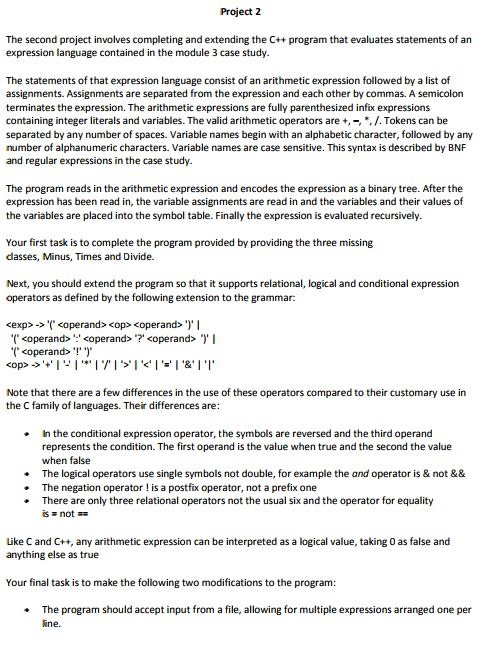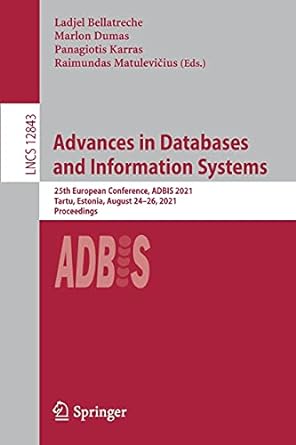Question
Module 3: Imperative LanguagesControl Flow An Expression Interpreter The case study for this module incorporates two of the language features that we discussedexpressions and assignments.


Module 3: Imperative LanguagesControl Flow
An Expression Interpreter
The case study for this module incorporates two of the language features that we discussedexpressions and assignments. The program interprets fully parenthesized arithmetic expressions that contain either literal values or variables. The variables must then subsequently be assigned values.
The grammar for the language that this interpreter accepts is defined by the following grammar:
, ; ( ) | | , | =
The regular expressions defining the three tokens are the following:
[+-*/] [a-zA-Z][a-zA-Z0-9]* [0-9]+
So, if you were to enter the following expression:
(x + (y * 3)), x = 2, y = 6;
the interpreter would respond:
Value = 20
The interpreter itself is written in C++. The complete program consists of 10 classes. We will present 7 of them. Your instructor may ask you to complete this program, perhaps enhance it, and add some error checking as one of the programming projects.
We begin with the main function and one subordinate function, which are contained in module3.cpp. The main function reads in the program, calls upon the static function parse of the SubExpression class to parse it, and builds an arithmetic expression tree. It then calls the subordinate function parseAssignments to parse the assignments and enter them into the symbol table, and then evaluates the expression and displays the result. That code is shown below:
#include#include #include using namespace std; #include "expression.h" #include "subexpression.h" #include "symboltable.h" #include "parse.h" SymbolTable symbolTable; void parseAssignments(); int main() { Expression* expression; char paren, comma; cout > paren; expression = SubExpression::parse(); cin >> comma; parseAssignments(); cout evaluate() > ws >> assignop >> value >> delimiter; symbolTable.insert(variable, value); } while (delimiter == ','); }
The arithmetic expression tree is built using an inheritance hierarchy. At the root of the hierarchy is the abstract class Expression. The class definition for Expression is contained in the file expression.h, shown below:
class Expression { public: virtual double evaluate() = 0; }; This abstract class has two subclasses. The first of these is SubExpression, which defines the node of the binary arithmetic expression tree. The class definition for SubExpression is contained in the file subexpression.h, shown below:
class SubExpression: public Expression { public: SubExpression(Expression* left, Expression* right); static Expression* parse(); protected: Expression* left; Expression* right; }; As is customary in C++, the bodies of the member functions of that class are contained in the file subexpression.cpp, shown below:
#includeusing namespace std; #include "expression.h" #include "subexpression.h" #include "operand.h" #include "plus.h" #include "minus.h" #include "times.h" #include "divide.h" SubExpression::SubExpression(Expression* left, Expression* right) { this->left = left; this->right = right; } Expression* SubExpression::parse() { Expression* left; Expression* right; char operation, paren; left = Operand::parse(); cin >> operation; right = Operand::parse(); cin >> paren; switch (operation) { case '+': return new Plus(left, right); case '-': return new Minus(left, right); case '*': return new Times(left, right); case '/': return new Divide(left, right); } return 0; }
The SubExpression class has four subclasses. We show one of themPlus. The class definition for Plus is contained in the file plus.h, shown below:
class Plus: public SubExpression { public: Plus(Expression* left, Expression* right): SubExpression(left, right) { } double evaluate() { return left->evaluate() + right->evaluate(); } }; Because the bodies of both member functions are inline, no corresponding .cpp file is required.
The other subclass of Expression is Operand, which defines the leaf nodes of the arithmetic expression tree. The class definition for Operand is contained in the file operand.h, shown below:
class Operand: public Expression { public: static Expression* parse(); }; The body of its only member function is contained in operand.cpp, shown below:
#include#include #include #include
using namespace std; #include "expression.h" #include "subexpression.h" #include "operand.h" #include "variable.h" #include "literal.h" #include "parse.h" Expression* Operand::parse() { char paren; double value; cin >> ws; if (isdigit(cin.peek())) { cin >> value; Expression* literal = new Literal(value); return literal; } if (cin.peek() == '(') { cin >> paren; return SubExpression::parse(); } else return new Variable(parseName()); return 0; }
The Operand class has two subclasses. The first is Variable, which defines leaf nodes of the tree that contain variables. The class definition for Variable is contained in the file variable.h, shown below:
class Variable: public Operand { public: Variable(string name) { this->name = name; } double Variable::evaluate(); private: string name; }; The body of its member function evaluate is contained in variable.cpp, shown below:
#include#include using namespace std; #include "expression.h" #include "operand.h" #include "variable.h" #include "symboltable.h" extern SymbolTable symbolTable; double Variable::evaluate() { return symbolTable.lookUp(name); }
The other subclass of Operand is Literal, which defines leaf nodes of the tree that contain literal values. The class definition for Literal is contained in the file literal.h, shown below:
class Literal: public Operand { public: Literal(int value) { this->value = value; } double evaluate() { return value; } private: int value; }; This interpreter uses a symbol table that is implemented with an unsorted list defined by the class SymbolTable. Its class definition is contained in the file symboltable.h, shown below:
class SymbolTable { public: SymbolTable() {} void insert(string variable, double value); double lookUp(string variable) const; private: struct Symbol { Symbol(string variable, double value) { this->variable = variable; this->value = value; } string variable; double value; }; vector elements; }; The bodies of its member functions are in the file symboltable.cpp, shown below:
#include#include using namespace std; #include "symboltable.h" void SymbolTable::insert(string variable, double value) { const Symbol& symbol = Symbol(variable, value); elements.push_back(symbol); } double SymbolTable::lookUp(string variable) const { for (int i = 0; i Finally, one utility function, parseName, is needed by this program. Its function prototype is the file parse.h, shown below:
string parseName();Its body is in parse.cpp, shown below:
#includeProject 2 program that evaluates statements of an The second project involves completing and extending the C+ expression language contained in the module 3 case study The statements of that expression language consist of an arithmetic expression followed by a list of assignments. Assignments are separated from the expression and each other by commas. A semicolon terminates the expression. The arithmetic expressions are fully parenthesized infix expressions containing integer literals and variables. The valid arithmetic operators are -*./. Tokens can be separated by any number of spaces. Variable names begin with an alphabetic character, followed by any number of alphanumeric characters. Variable names are case sensitive. This syntax is described by BNF and regular expressions in the case study The program reads in the arithmetic expression and encodes the expression as a binary tree. After the expression has been read in, the variable assignments are read in and the variables and their values of the variables are placed into the symbol table. Finally the expression is evaluated recursively Your first task is to complete the program provided by providing the three missing dasses, Minus, Times and Divide. Next, you should extend the program so that it supports relational, logical and conditional expression operators as defined by the following extension to the grammar: exp>-> '('#include #include using namespace std; #include "parse.h" string parseName() { char alnum; string name = ""; cin >> ws; while (isalnum(cin.peek())) { cin >> alnum; name += alnum; } return name; } '). I "(. Note that there are a few differences in the use of these operators compared to their customary use in the C family of languages. Their differences are in the conditional expression operator, the symbols are reversed and the third operand represents the condition. The first operand is the value when true and the second the value when false . The logical operators use single symbols not double, for example the and operator is & not && . The negation operator ! is a postfix operator, not a prefix one . There are only three relational operators not the usual six and the operator for equality is not Like C and C++, any arithmetic expression can be interpreted as a logical value, taking 0 as false and anything else as true Your final task is to make the following two modifications to the program The program should accept input from a file, allowing for multiple expressions arranged one per ine. . Project 2 program that evaluates statements of an The second project involves completing and extending the C+ expression language contained in the module 3 case study The statements of that expression language consist of an arithmetic expression followed by a list of assignments. Assignments are separated from the expression and each other by commas. A semicolon terminates the expression. The arithmetic expressions are fully parenthesized infix expressions containing integer literals and variables. The valid arithmetic operators are -*./. Tokens can be separated by any number of spaces. Variable names begin with an alphabetic character, followed by any number of alphanumeric characters. Variable names are case sensitive. This syntax is described by BNF and regular expressions in the case study The program reads in the arithmetic expression and encodes the expression as a binary tree. After the expression has been read in, the variable assignments are read in and the variables and their values of the variables are placed into the symbol table. Finally the expression is evaluated recursively Your first task is to complete the program provided by providing the three missing dasses, Minus, Times and Divide. Next, you should extend the program so that it supports relational, logical and conditional expression operators as defined by the following extension to the grammar: exp>-> '(' '). I "(. Note that there are a few differences in the use of these operators compared to their customary use in the C family of languages. Their differences are in the conditional expression operator, the symbols are reversed and the third operand represents the condition. The first operand is the value when true and the second the value when false . The logical operators use single symbols not double, for example the and operator is & not && . The negation operator ! is a postfix operator, not a prefix one . There are only three relational operators not the usual six and the operator for equality is not Like C and C++, any arithmetic expression can be interpreted as a logical value, taking 0 as false and anything else as true Your final task is to make the following two modifications to the program The program should accept input from a file, allowing for multiple expressions arranged one per ine
Step by Step Solution
There are 3 Steps involved in it
Step: 1

Get Instant Access to Expert-Tailored Solutions
See step-by-step solutions with expert insights and AI powered tools for academic success
Step: 2

Step: 3

Ace Your Homework with AI
Get the answers you need in no time with our AI-driven, step-by-step assistance
Get Started


